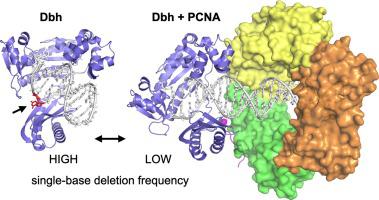DNA Repair ( IF 3.8 ) Pub Date : 2020-09-06 , DOI: 10.1016/j.dnarep.2020.102967 Yifeng Wu 1 , William J Jaremko 2 , Ryan C Wilson 2 , Janice D Pata 1

|
Dbh is a Y-family translesion DNA polymerase from Sulfolobus acidocaldarius, an archaeal species that grows in harsh environmental conditions. Biochemically, Dbh displays a distinctive mutational profile, creating single-base deletion mutations at extraordinarily high frequencies (up to 50 %) in specific repeat sequences. In cells, however, Dbh does not appear to contribute significantly to spontaneous frameshifts in these same sequence contexts. This suggests that either the error-prone DNA synthesis activity of Dbh is reduced in vivo and/or Dbh is restricted from replicating these sequences. Here, we test the hypothesis that the propensity for Dbh to make single base deletion mutations is reduced through interaction with the S. acidocaldarius heterotrimeric sliding clamp processivity factor, PCNA-123. We first confirm that Dbh physically interacts with PCNA-123, with the interaction requiring both the PCNA-1 subunit and the C-terminal 10 amino acids of Dbh, which contain a predicted PCNA-interaction peptide (PIP) motif. This interaction stimulates the polymerase activity of Dbh, even on short, linear primer-template DNA, by increasing the rate of nucleotide incorporation. This stimulation requires an intact PCNA-123 heterotrimer and a DNA duplex length of at least 18 basepairs, the minimal length predicted from structural data to bind to both the polymerase and the clamp. Finally, we find that PCNA-123 increases the fidelity of Dbh on a single-base deletion hotspot sequence 3-fold by promoting an increase in the rate of correct, but not incorrect, nucleotide addition and propose that PCNA-123 induces Dbh to adopt a more active conformation that is less prone to creating deletions during DNA synthesis.
中文翻译:

异源三聚体 PCNA 增加了 Dbh 的活性和保真度,Dbh 是一种易于产生单碱基缺失突变的 Y 家族转移 DNA 聚合酶。
Dbh 是来自Sulfolobus acidocaldarius的 Y 家族转移 DNA 聚合酶,这是一种在恶劣环境条件下生长的古菌。在生化方面,Dbh 显示出独特的突变谱,在特定重复序列中以极高的频率(高达 50%)产生单碱基缺失突变。然而,在细胞中,Dbh 似乎对这些相同序列上下文中的自发移码没有显着贡献。这表明 Dbh 容易出错的 DNA 合成活性在体内降低和/或 Dbh 复制这些序列受到限制。在这里,我们测试了以下假设:通过与S. acidocaldarius 的相互作用降低了 Dbh 进行单碱基缺失突变的倾向异源三聚体滑动钳持续合成因子,PCNA-123。我们首先确认 Dbh 与 PCNA-123 物理相互作用,相互作用需要 PCNA-1 亚基和 Dbh 的 C 端 10 个氨基酸,其中包含预测的 PCNA 相互作用肽 (PIP) 基序。这种相互作用通过增加核苷酸掺入率来刺激 Dbh 的聚合酶活性,即使在短的线性引物模板 DNA 上也是如此。这种刺激需要完整的 PCNA-123 异源三聚体和至少 18 个碱基对的 DNA 双链体长度,这是根据结构数据预测的与聚合酶和夹子结合的最小长度。最后,我们发现 PCNA-123 通过促进正确但不错误的比率的增加,将 Dbh 在单碱基缺失热点序列上的保真度提高了 3 倍,



























 京公网安备 11010802027423号
京公网安备 11010802027423号